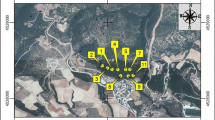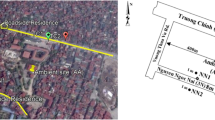Abstract
The spatial and temporal variations of PM2.5, PM10 and TSP in three African cities of different sizes (Dar es Salaam, Ouagadougou and Gaborone) were investigated using portable particle counters. Three different areas (downtown, green residential and traditional residential) and a reference site were designated in each of the cities in order to detect intra-urban and temporal variability. Morning, noon and night measurements were conducted in the urban areas while observations at reference stations were made continuously over the field periods. A clear diurnal pattern in particle concentrations was found in inland Gaborone and Ouagadougou, with morning and night peaks where the latter was the highest. However, in coastal Dar es Salaam the night peak was almost absent due to delayed stabilisation of the air. Particle concentrations at the Ouagadougou reference station were extreme. The direct contribution of vehicle emissions are of secondary importance since the PM2.5/PM10 ratios are low (0.1–0.3). Much of the particles are supposed to be soil particles that are entrained in the air by daytime high windspeeds followed by nighttime subsidence as the air is stabilised and windspeed decreases. However, in all three cities, resuspension are important as areas with a network of unpaved roads showed the highest concentrations of suspended particles. Generally, the central business district had the lowest concentrations of particulate matter.
Similar content being viewed by others
References
Allegrini, I., Febo, A., Pasini, A., & Schiarini, S. (1994). Monitoring of the nocturnal mixed layer by means of particulate radon progeny measurement. Journal of Geophysical Research—Atmospheres, 99(D9), 18765–18777.
Artíñano, B., Salvador, P., Alonso, D. G., Querol, X., & Alastuey, A. (2004). Influence of traffic on the PM10 and PM2.5 urban aerosol fractions in Madrid (Spain). The Science of the Total Environment, 334–335, 111–123.
Baumbach, G., Vogt, U., Hein, K. R. G., Oluwole, A. F., Ogunsola, O. J., Olaniyi, H. B., et al. (1995). Air pollution in a large tropical city with high traffic density—results of measurements in Lagos, Nigeria. The Science of the Total Environment, 169, 25–31.
Begum, B. A., Biswas, S. K., & Hopke, P. K. (2006). Temporal variations and spatial distribution of ambient PM2.2 and PM10 concentrations in Dhaka, Bangladesh. The Science of the Total Environment, 358, 36–45.
Buckle, C. (1996). Weather and climate in Africa (p. 312). Essex, UK: Addison Wesley Longman Limited.
Chan, L. Y., Kwok, W. S., Lee, S. C., & Chan, C. Y. (2001). Spatial variation of mass concentration of roadside suspended particulate matter in metropolitan Hong Kong. Atmospheric Environment, 35, 3167–3176.
Chimidza, S., & Moloi, K. (2000). Identification of sources of aerosol articles in three locations in eastern Botswana. Journal of Geophysical Research, 105(D14), 17811–17818.
Chow, J. C., Watson, J. G., Edgerton, S. A., & Vega, E. (2002). Chemical composition of PM2.5 and PM10 in Mexico City during winter 1997. The Science of the Total Environment, 287, 177–201.
Clark, I., Assamoi, P., Bertrand, J., & Giorgi, F. (2004). Characterization of potential zones of dust generation at eleven stations in the southern Sahara. Theoretical and Applied Climatology, 77, 173–184.
Cohen, B. (2004). Urban growth in developing countries: A review of current trends and a caution regarding existing forecasts. World Development, 32, 23–51.
Das, M., Kumar Maiti, S., & Mukhopadhyay, U. (2006). Distribution of PM2.5 and PM10 − 2.5 in PM10 fraction in ambient air due to vehicular pollution in Kolkata megacity. Environmental Monitoring and Assessment, 122, 111–123.
Diallo, M. (2004). Regional conference on the suppression of lead in gasoline in sub-Sahara Africa. http://www.cleanairnet.org/ssa/1414/articles-36194_Diallo_pdf.pdf. Accessed 27 October 2004.
Elminir, H. K. (2005). Dependence of urban air pollutants on meteorology. The Science of the Total Environment, 350, 225–237.
Englert, N. (2004). Fine particles and human health—a review of epidemiological studies. Toxicology Letters, 149, 235–242.
Etyemezian, V., Tesfaye, M., Yimer, A., Chow, J. C., Mesfin, D., Nega, T., et al. (2005). Results from a pilot-scale air quality study in Addis Ababa, Ethiopia. Atmospheric Environment, 39, 7849–7860.
Fang, G.-C., Chang, C.-N., Wu, Y.-S., Fu, P. P.-C., Yang, D.-G., & Chu, C.-C. (1999). Characterization of chemical species in PM2.5 and PM10 aerosols in suburban and rural sites of central Taiwan. Science of The Environment, 234, 203–212.
Gomišček, B., Hauck, H., Stopper, S., & Preining, O. (2004). Spatial and temporal variations of PM1, PM2.5, PM10 and particle number concentration during the AUPHEP-project. Atmospheric Environment, 38, 3917–3934.
Gupta, A. K., Nag, S., & Mukhopadyay, U. K. (2006). Characterization of PM10, PM2.5 and benzene soluble organic fraction of particulate matter in an urban area of Kolkata, India. Environmental Monitoring and Assessment, 115, 205–222.
Gupta, A. K., Patil, R. S., & Gupta, S. K. (2004). A statistical analysis of particulate data sets for JawaharlalNehru Port and surrounding harbour region in India. Environmental Monitoring and Assessment, 95, 295–309.
Hazenkamp von Arx, M. E., Götschi, T., Acermann-Liebrich, U., Bono, R., Burney, P., Cyrys, J., et al. (2004). PM2.5 and NO2 assessment in 21 European study centres of ECRHS II: Annual means and seasonal differences. Atmospheric Environment, 38, 1943–1953.
Henricsson, D. (1999). Air pollution by motor traffic in Dar es Salaam—measurements and state of the art description. KFB-meddelande, 1998:8, Stockholm, 25 pp.
Hien, P. D., Bac, V. T., Tham, H. C., Nhan, D. D., & Vinh, L. D. (2002). Influence of meteorological conditions on PM2.5 and PM2.5 − 10 concentrations during the monsoon season in Hanoi, Vietnam. Atmospheric Environment, 36, 3473–3484.
Houser, C. A., & Nickling, W. G. (2001). The emission and vertical flux of particulate matter <10 μm from a disturbed clay-crusted surface. Sedimentology, 48, 255–267.
Isidoro-Valeroso, I., & Monteverde, C. A. (1992). Diurnal variations of air pollution over metropolitan Manila. Atmósfera, 5, 241–257.
Jackson, M. M. (2005). Roadside concentration of gaseous and particulate matter pollutants and risk assessment in Dar es-Salaam, Tanzania. Environmental Monitoring and Assessment, 1004, 385–407.
Jayaratne, E. R., & Verma, T. S. (2001). The impact of biomass burning on the environmental aerosol concentration in Gaborone, Botswana. Atmospheric Environment, 35, 1821–1828.
Jonsson, P. (2005). Urban climate and air quality in tropical areas, A98. PhD-dissertation, Department of Physical Geography, Earth Sciences Centre, Göteborg University.
Kanbour, F. I., Altai, F. A., Yassin, S., Harrison, R. M., & Kitto, A.-M. N. (1990). A comparison of smoke shade and gravimetric determination of suspended particulate matter in a semi-arid climate (Baghdad, Iraq). Atmospheric Environment, 24A, 1297–1301.
Kaushik, C. P., Ravindra, K., Yadav, K., Mehta, S., & Haritash, A. K. (2006). Assessment of ambient air quality in urban centres of Haryana (India) in relation to different anthropogenic activities and health risks. Environmental Monitoring and Assessment, 122, 27–40.
Kitilla, M. L. D. (1999). Status of the air pollution in Dar es Salaam City. Sustainable cities programme Tanzania, Urban Authorities Support Unit, 11 pp.
Koleleni, Y. I. A. (2002). Environmental air degradation in Dar es Salaam by X-ray fluorescence. Journal of Environmental Science and Health. Part A, Environmental Science and Engineering & Toxic and Hazardous Substance Control, 37(3), 385–398.
Kumar, R., & Joseph, A. B. (2006). Air pollution concentrations of PM2.5, PM10 and NO2 at ambient and kerbsite and their correlation in metro city—Mumbai. Environmental Monitoring and Assessment, 119, 191–199.
Latha, K., & Badarinath, K. V. S. (2005). Seasonal variations of black carbon aerosols and total aerosol mass concentrations over urban environment in India. Atmospheric Environment, 39, 4129–4141.
Liu, C.-M., Young, C.-Y., & Lee, Y.-C. (2006). Influence of Asian dust storms on air quality in Taiwan. The Science of the Total Environment, 368, 884–897.
Mahrt, L., & Ek, M. (1984). The influence of atmospheric stability on potential evaporation. Journal of Climate and Applied Meteorology, 23, 222–234.
Masmoudi, M., Chaabane, M., Tanré, D., Gouloup, P., Blarel, L., & Elleuch, F. (2003). Spatial and temporal variability of aerosol: Size distribution and optical properties. Atmospheric Research, 66, 1–19.
Mbuligwe, S. E., & Kassenga, G. R. (1997). Automobile air pollution in Dar es Salaam, Tanzania. The Science of the Total Environment, 199, 227–235.
Mok, K. M., & Hoi, K. I. (2005). Effects of meteorological conditions of PM10 concentrations—a study in Macau. Environmental Monitoring and Assessment, 102, 201–223.
Mönkkönen, P., Uma, R., Srinivasan, D., Koponen, I. K., Lehtinen, K. E. J., Hämeri, K., et al. (2004). Relationships and variations of aerosol number and PM10 mass concentration in a highly polluted urban environment—New Delhi, India. Atmospheric Environment, 38, 425–433.
Mouli, P. C., Mohan, S. V., & Reddy, S. J. (2006). Chemical composition of atmospheric aerosol (PM10) at a semi-arid urban site: Influence of terrestrial sources. Environmental Monitoring and Assessment, 117, 291–305.
Nieuwolt, S. (1973). Breezes along the Tanzanian coast. Archiv für Meteorologie, Geophysik und Bioklimatologie. Ser. B, 21, 189–206.
N’Tchayi Mbourou, G., Bertrand, J. J., & Nicholson, S. E. (1997). The diurnal and seasonal cycles of wind-borne dust over Africa north of the equator. Journal of Applied Meteorology, 36, 868–881.
Ozer, P., Laghdaf, M. B. O. M., Lemine, S. O. M., & Gassani, J. (2007). Estimation of air quality degradation due to Saharan dust at Nouakchott, Mauretania, from horizontal visibility data. Water, Air, and Soil Pollution, 178, 79–87.
Panther, B. C., Hooper, M. A., & Tapper, N. J. (1999). A comparison of air particulate matter and associated polycyclic aromatic hydrocarbons in some tropical and temperate urban environments. Atmospheric Environment, 33, 4087–4099.
Parekh, P. P., Khwaja, H. A., Khan, A. R., Naqvi, R. R., Malik, A., Shah, S. A., et al. (2001). Ambient air quality of two metropolitan cities of Pakistan and its health effects. Atmospheric Environment, 35, 5971–5978.
Querol, X., Alastuey, A., Rodriguez, S., Plana, F., Ruiz, C. R., Cots, N., et al. (2001). PM10 and PM2.5 source appointment in the Barcelona Metropolitan area, Catalonia, Spain. Atmospheric Environment, 35, 6407–6419.
Romero, H., Ihl, M., Rivera, A., Zalazar, P., & Azocar, P. (1999). Rapid urban growth, land-use changes and air pollution in Santiago, Chile. Atmospheric Environment, 33, 4039–4047.
Sharma, M., & Maloo, S. (2005). Assessment of ambient PM10 and PM2.5 and characterization of PM10 in the city of Kanpur, India. Atmospheric Environment, 39, 6015–6026.
Tiwari, Y. K., Devara, P. C. S., Raj, P. E., Maheskumar, R. S., Pandithurai, G., & Dani, K. K. (2003). Tropical urban aerosol distributions during pre-sunrise and post-sunset as observed with lidar and solar radiometer at Pune, India. Journal of Aerosol Science, 34, 449–458.
Trewartha, G. T. (1982). The Earth’s problem climates. London, UK: The University of Wisconsin Press (pp. 334)
United Nations (2004). World urbanization prospects: The 2003 revision. New York: United Nations.
Viana, M., Querol, X., Alastuey, A., Gangoiti, G., & Menéndez, M. (2003). PM levels in the Basque Country (Northern Spain): Analysis of a 5-year record and interpretation of seasonal variations. Atmospheric Environment, 37, 2879–2891.
World Bank (1996). Rural energy and development: Improving energy supplies for two billion people (p. 26). Washington, D.C., USA: The World Bank.
World Bank (2004). World development indicators database, August 2004. http://devdata.worldbank.org. Accessed 22 March 2005.
Worldclimate monthly temperature and precipitation of world cities, http://www.worldclimate.com. Accessed 15 March 2005.
Xiao, F., Brajer, V., & Mead, R. W. (2006). Blowing in the wind: The impact of China’s Pearl river Delta on Hong Kong’s air quality. The Science of the Total Environment, 367, 96–111.
Author information
Authors and Affiliations
Corresponding author
Rights and permissions
About this article
Cite this article
Eliasson, I., Jonsson, P. & Holmer, B. Diurnal and intra-urban particle concentrations in relation to windspeed and stability during the dry season in three African cities. Environ Monit Assess 154, 309–324 (2009). https://doi.org/10.1007/s10661-008-0399-y
Received:
Accepted:
Published:
Issue Date:
DOI: https://doi.org/10.1007/s10661-008-0399-y




